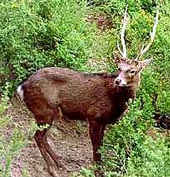You
may get surprised at Assateague Island when you encounter the
Sika deer during your vacation. Introduced on Assateague Island
during the mid 1920's, Sika can been seen in the loblolly pine
forest, sand dune areas and marshes along Assateague. They are
inhabitants of Japan and live naturally throughout eastern Asia,
including parts of Korea, Siberia, China, Vietnam, Taiwan. Although
smaller than whitetail deer, these animals exhibit elk-like behavior.
Often called "Asian elk", they sometimes offer visitors
a chance to witness exciting physical challenges between males
during the sika's mating season. Sika eat the leaves of myrtle
bushes, grasses, persimmons, shrubs, and other plants on Assateague
Island. They even eat poison ivy.
Sika
are highly vocal and at least ten different sounds have been recorded.
There
are several subspecies and their fur can range in color from chestnut-brown
with reddish hair on top of the head to a dark brown or black
They have white spots on their backs which appear more visible
during different seasons. Scientists are still trying to figure
out how many subspecies exist, but currently recognize six to
14 kinds of sika. About Six subspecies are nearly extinct in certain
areas of Asia. Sika deer have been transplanted to several countries
and have been known to mate with red deer, therefore producing
hybrids which are larger than Sika. They have been introduced
in New Zealand, Europe, Australia, and several US states, including
Maryland, Virginia, Texas, Oklahoma and Wisconsin.

